Employee Moods & Emotions: BUMGT5921 Virginia Healthcare Report
VerifiedAdded on 2023/01/04
|9
|2552
|74
Report
AI Summary
This report examines the impact of employee moods and emotions on the performance of a healthcare unit within ABC Healthcare Pvt. Ltd. The study focuses on a surgery unit in Virginia experiencing downturns due to negative employee emotions and moods, which are linked to issues like staff shortages, a poor work culture, and inadequate rewards and recognition. The report delves into the concepts of moods and emotions in the workplace, highlighting their effects on employee behavior and overall performance. It then provides recommendations for improvement, including implementing Herzberg's Two-Factor Theory to address hygiene and motivation factors, increasing emotional quotient among employees, and considering job characteristics and fairness. The report concludes by emphasizing the need for immediate solutions to prevent further damage to the company's reputation and improve patient care. The report is based on the course BUMGT5921 on Organisations: Behaviour, Structure, Process.
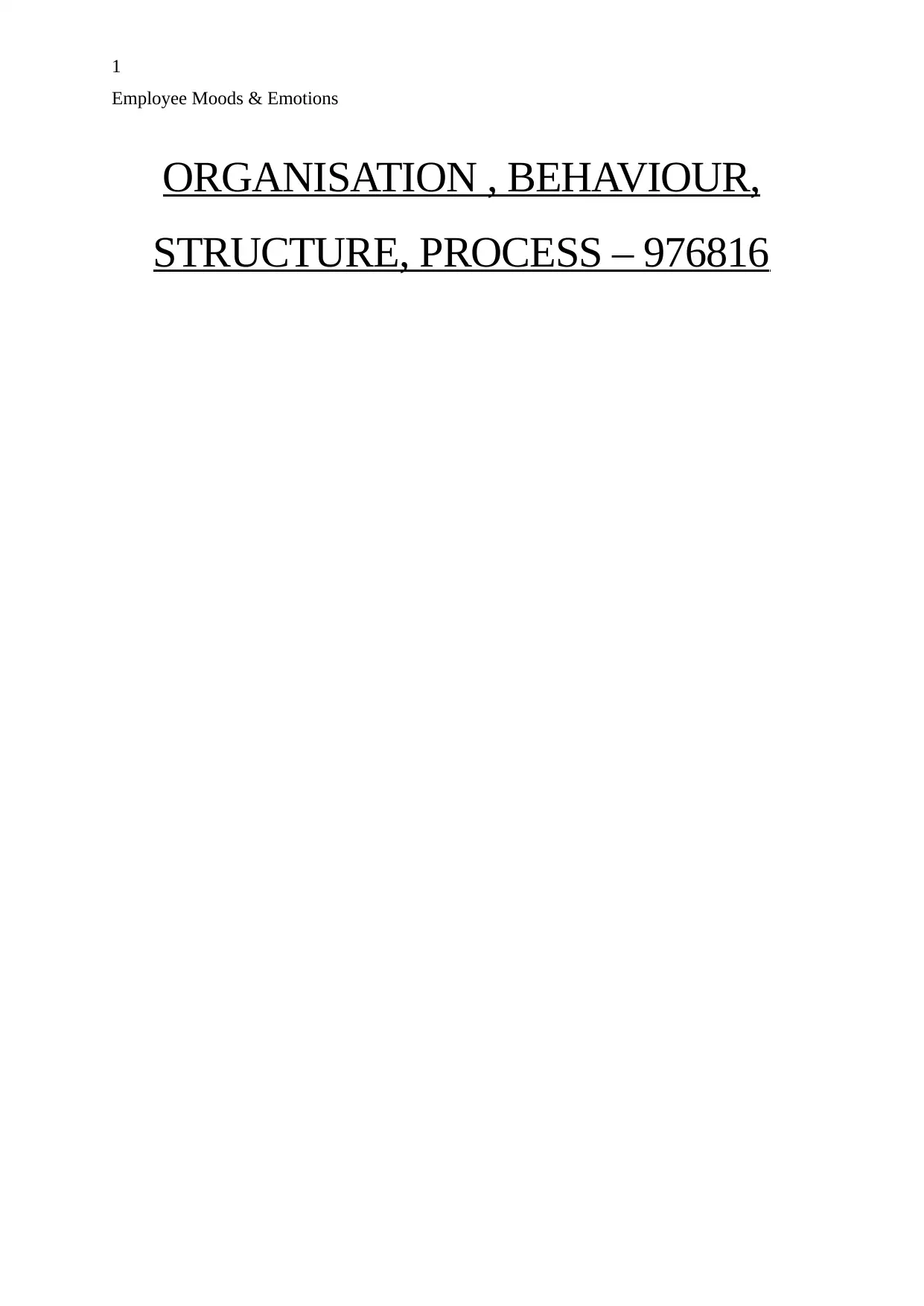
1
Employee Moods & Emotions
ORGANISATION , BEHAVIOUR,
STRUCTURE, PROCESS – 976816
Employee Moods & Emotions
ORGANISATION , BEHAVIOUR,
STRUCTURE, PROCESS – 976816
Paraphrase This Document
Need a fresh take? Get an instant paraphrase of this document with our AI Paraphraser
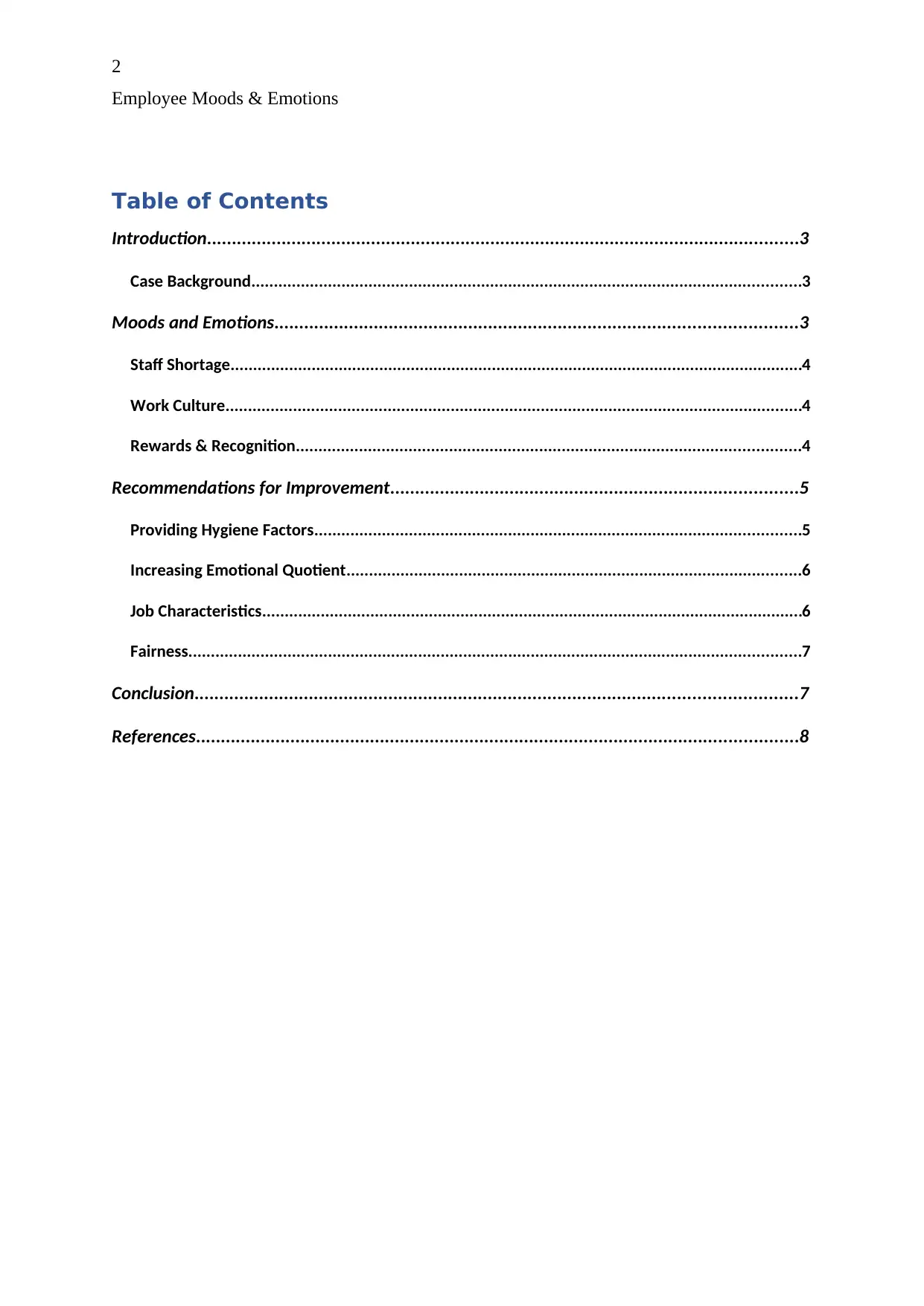
2
Employee Moods & Emotions
Table of Contents
Introduction.......................................................................................................................3
Case Background..........................................................................................................................3
Moods and Emotions.........................................................................................................3
Staff Shortage...............................................................................................................................4
Work Culture................................................................................................................................4
Rewards & Recognition................................................................................................................4
Recommendations for Improvement..................................................................................5
Providing Hygiene Factors............................................................................................................5
Increasing Emotional Quotient.....................................................................................................6
Job Characteristics........................................................................................................................6
Fairness........................................................................................................................................7
Conclusion.........................................................................................................................7
References.........................................................................................................................8
Employee Moods & Emotions
Table of Contents
Introduction.......................................................................................................................3
Case Background..........................................................................................................................3
Moods and Emotions.........................................................................................................3
Staff Shortage...............................................................................................................................4
Work Culture................................................................................................................................4
Rewards & Recognition................................................................................................................4
Recommendations for Improvement..................................................................................5
Providing Hygiene Factors............................................................................................................5
Increasing Emotional Quotient.....................................................................................................6
Job Characteristics........................................................................................................................6
Fairness........................................................................................................................................7
Conclusion.........................................................................................................................7
References.........................................................................................................................8
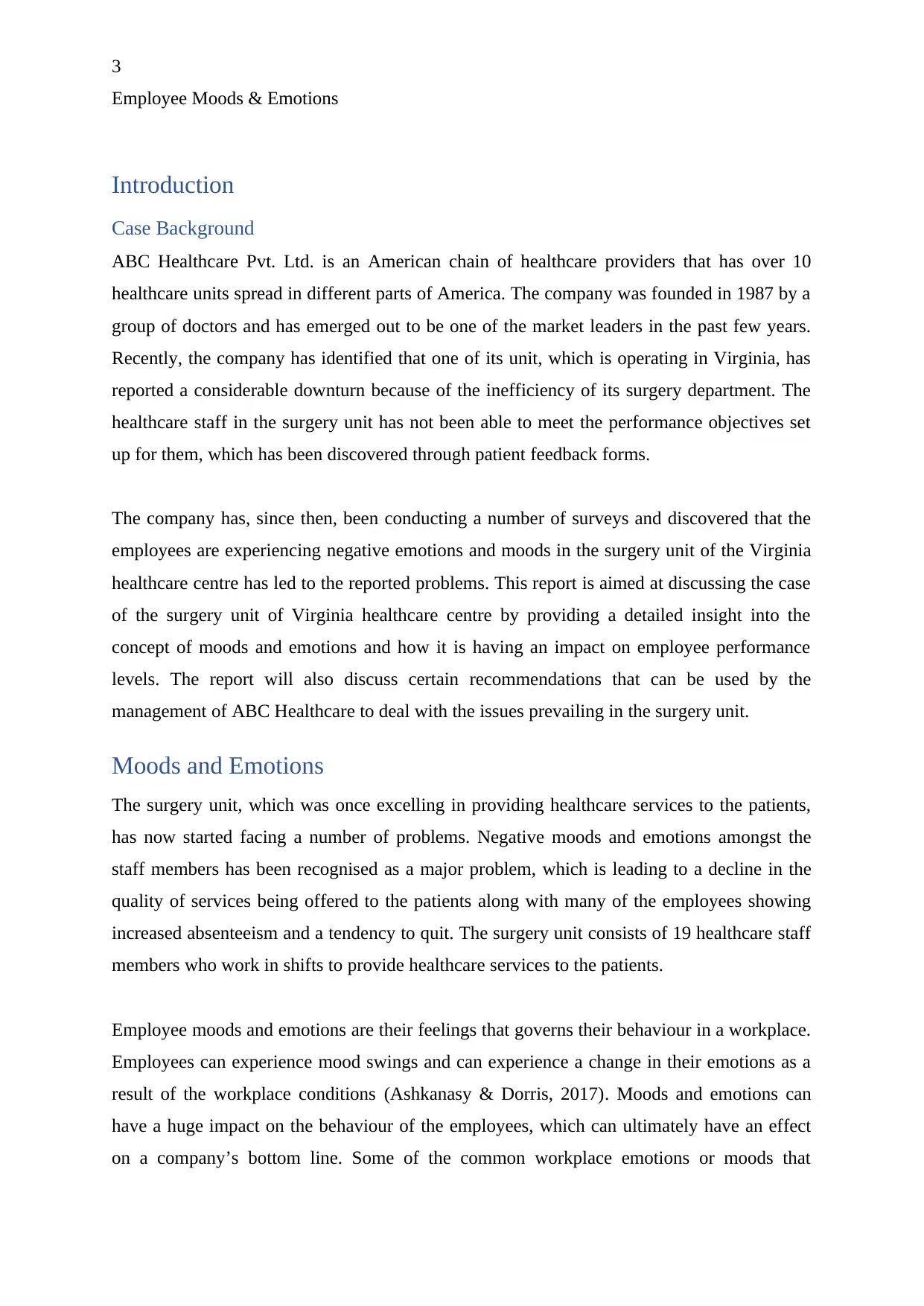
3
Employee Moods & Emotions
Introduction
Case Background
ABC Healthcare Pvt. Ltd. is an American chain of healthcare providers that has over 10
healthcare units spread in different parts of America. The company was founded in 1987 by a
group of doctors and has emerged out to be one of the market leaders in the past few years.
Recently, the company has identified that one of its unit, which is operating in Virginia, has
reported a considerable downturn because of the inefficiency of its surgery department. The
healthcare staff in the surgery unit has not been able to meet the performance objectives set
up for them, which has been discovered through patient feedback forms.
The company has, since then, been conducting a number of surveys and discovered that the
employees are experiencing negative emotions and moods in the surgery unit of the Virginia
healthcare centre has led to the reported problems. This report is aimed at discussing the case
of the surgery unit of Virginia healthcare centre by providing a detailed insight into the
concept of moods and emotions and how it is having an impact on employee performance
levels. The report will also discuss certain recommendations that can be used by the
management of ABC Healthcare to deal with the issues prevailing in the surgery unit.
Moods and Emotions
The surgery unit, which was once excelling in providing healthcare services to the patients,
has now started facing a number of problems. Negative moods and emotions amongst the
staff members has been recognised as a major problem, which is leading to a decline in the
quality of services being offered to the patients along with many of the employees showing
increased absenteeism and a tendency to quit. The surgery unit consists of 19 healthcare staff
members who work in shifts to provide healthcare services to the patients.
Employee moods and emotions are their feelings that governs their behaviour in a workplace.
Employees can experience mood swings and can experience a change in their emotions as a
result of the workplace conditions (Ashkanasy & Dorris, 2017). Moods and emotions can
have a huge impact on the behaviour of the employees, which can ultimately have an effect
on a company’s bottom line. Some of the common workplace emotions or moods that
Employee Moods & Emotions
Introduction
Case Background
ABC Healthcare Pvt. Ltd. is an American chain of healthcare providers that has over 10
healthcare units spread in different parts of America. The company was founded in 1987 by a
group of doctors and has emerged out to be one of the market leaders in the past few years.
Recently, the company has identified that one of its unit, which is operating in Virginia, has
reported a considerable downturn because of the inefficiency of its surgery department. The
healthcare staff in the surgery unit has not been able to meet the performance objectives set
up for them, which has been discovered through patient feedback forms.
The company has, since then, been conducting a number of surveys and discovered that the
employees are experiencing negative emotions and moods in the surgery unit of the Virginia
healthcare centre has led to the reported problems. This report is aimed at discussing the case
of the surgery unit of Virginia healthcare centre by providing a detailed insight into the
concept of moods and emotions and how it is having an impact on employee performance
levels. The report will also discuss certain recommendations that can be used by the
management of ABC Healthcare to deal with the issues prevailing in the surgery unit.
Moods and Emotions
The surgery unit, which was once excelling in providing healthcare services to the patients,
has now started facing a number of problems. Negative moods and emotions amongst the
staff members has been recognised as a major problem, which is leading to a decline in the
quality of services being offered to the patients along with many of the employees showing
increased absenteeism and a tendency to quit. The surgery unit consists of 19 healthcare staff
members who work in shifts to provide healthcare services to the patients.
Employee moods and emotions are their feelings that governs their behaviour in a workplace.
Employees can experience mood swings and can experience a change in their emotions as a
result of the workplace conditions (Ashkanasy & Dorris, 2017). Moods and emotions can
have a huge impact on the behaviour of the employees, which can ultimately have an effect
on a company’s bottom line. Some of the common workplace emotions or moods that
⊘ This is a preview!⊘
Do you want full access?
Subscribe today to unlock all pages.

Trusted by 1+ million students worldwide
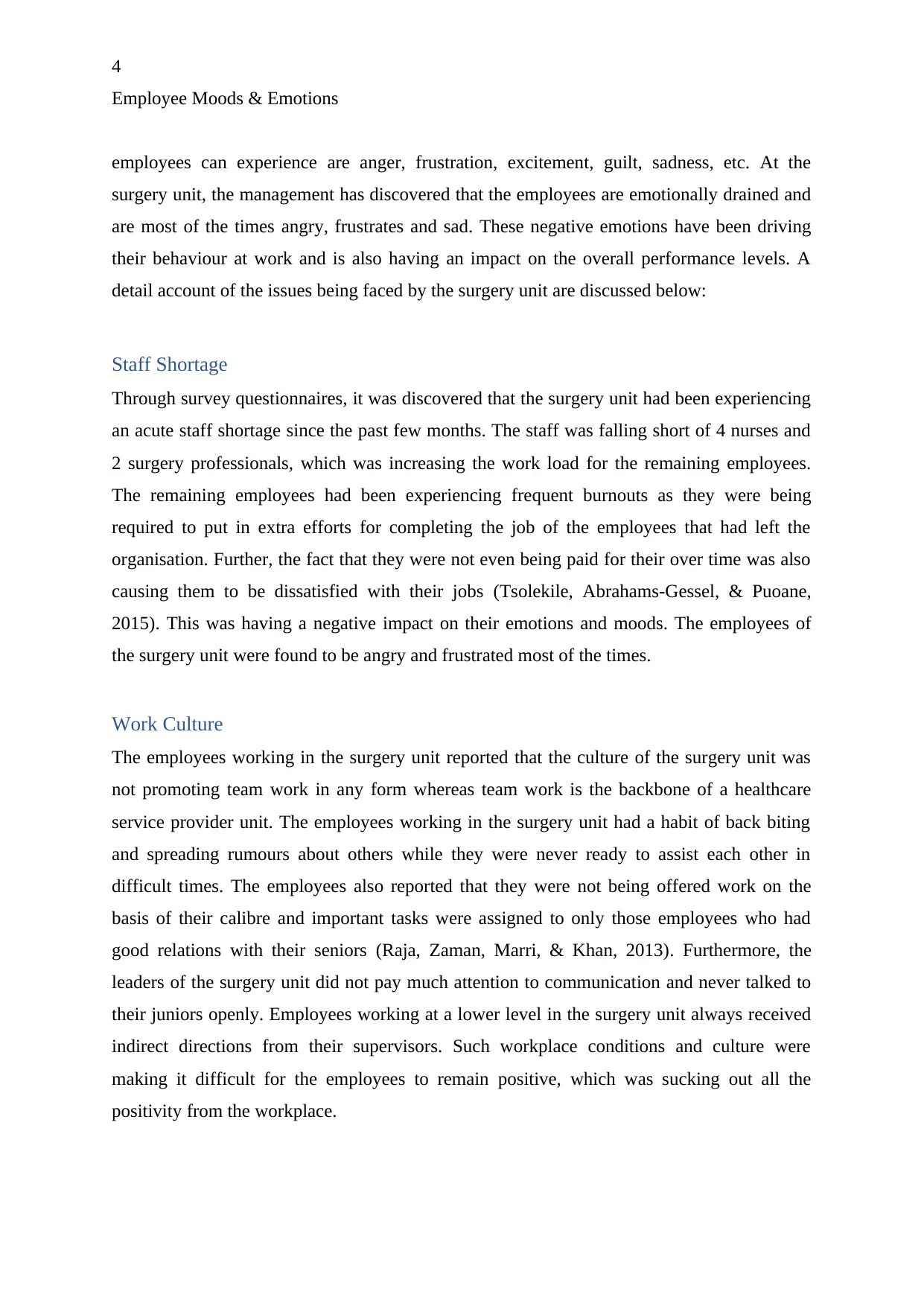
4
Employee Moods & Emotions
employees can experience are anger, frustration, excitement, guilt, sadness, etc. At the
surgery unit, the management has discovered that the employees are emotionally drained and
are most of the times angry, frustrates and sad. These negative emotions have been driving
their behaviour at work and is also having an impact on the overall performance levels. A
detail account of the issues being faced by the surgery unit are discussed below:
Staff Shortage
Through survey questionnaires, it was discovered that the surgery unit had been experiencing
an acute staff shortage since the past few months. The staff was falling short of 4 nurses and
2 surgery professionals, which was increasing the work load for the remaining employees.
The remaining employees had been experiencing frequent burnouts as they were being
required to put in extra efforts for completing the job of the employees that had left the
organisation. Further, the fact that they were not even being paid for their over time was also
causing them to be dissatisfied with their jobs (Tsolekile, Abrahams-Gessel, & Puoane,
2015). This was having a negative impact on their emotions and moods. The employees of
the surgery unit were found to be angry and frustrated most of the times.
Work Culture
The employees working in the surgery unit reported that the culture of the surgery unit was
not promoting team work in any form whereas team work is the backbone of a healthcare
service provider unit. The employees working in the surgery unit had a habit of back biting
and spreading rumours about others while they were never ready to assist each other in
difficult times. The employees also reported that they were not being offered work on the
basis of their calibre and important tasks were assigned to only those employees who had
good relations with their seniors (Raja, Zaman, Marri, & Khan, 2013). Furthermore, the
leaders of the surgery unit did not pay much attention to communication and never talked to
their juniors openly. Employees working at a lower level in the surgery unit always received
indirect directions from their supervisors. Such workplace conditions and culture were
making it difficult for the employees to remain positive, which was sucking out all the
positivity from the workplace.
Employee Moods & Emotions
employees can experience are anger, frustration, excitement, guilt, sadness, etc. At the
surgery unit, the management has discovered that the employees are emotionally drained and
are most of the times angry, frustrates and sad. These negative emotions have been driving
their behaviour at work and is also having an impact on the overall performance levels. A
detail account of the issues being faced by the surgery unit are discussed below:
Staff Shortage
Through survey questionnaires, it was discovered that the surgery unit had been experiencing
an acute staff shortage since the past few months. The staff was falling short of 4 nurses and
2 surgery professionals, which was increasing the work load for the remaining employees.
The remaining employees had been experiencing frequent burnouts as they were being
required to put in extra efforts for completing the job of the employees that had left the
organisation. Further, the fact that they were not even being paid for their over time was also
causing them to be dissatisfied with their jobs (Tsolekile, Abrahams-Gessel, & Puoane,
2015). This was having a negative impact on their emotions and moods. The employees of
the surgery unit were found to be angry and frustrated most of the times.
Work Culture
The employees working in the surgery unit reported that the culture of the surgery unit was
not promoting team work in any form whereas team work is the backbone of a healthcare
service provider unit. The employees working in the surgery unit had a habit of back biting
and spreading rumours about others while they were never ready to assist each other in
difficult times. The employees also reported that they were not being offered work on the
basis of their calibre and important tasks were assigned to only those employees who had
good relations with their seniors (Raja, Zaman, Marri, & Khan, 2013). Furthermore, the
leaders of the surgery unit did not pay much attention to communication and never talked to
their juniors openly. Employees working at a lower level in the surgery unit always received
indirect directions from their supervisors. Such workplace conditions and culture were
making it difficult for the employees to remain positive, which was sucking out all the
positivity from the workplace.
Paraphrase This Document
Need a fresh take? Get an instant paraphrase of this document with our AI Paraphraser
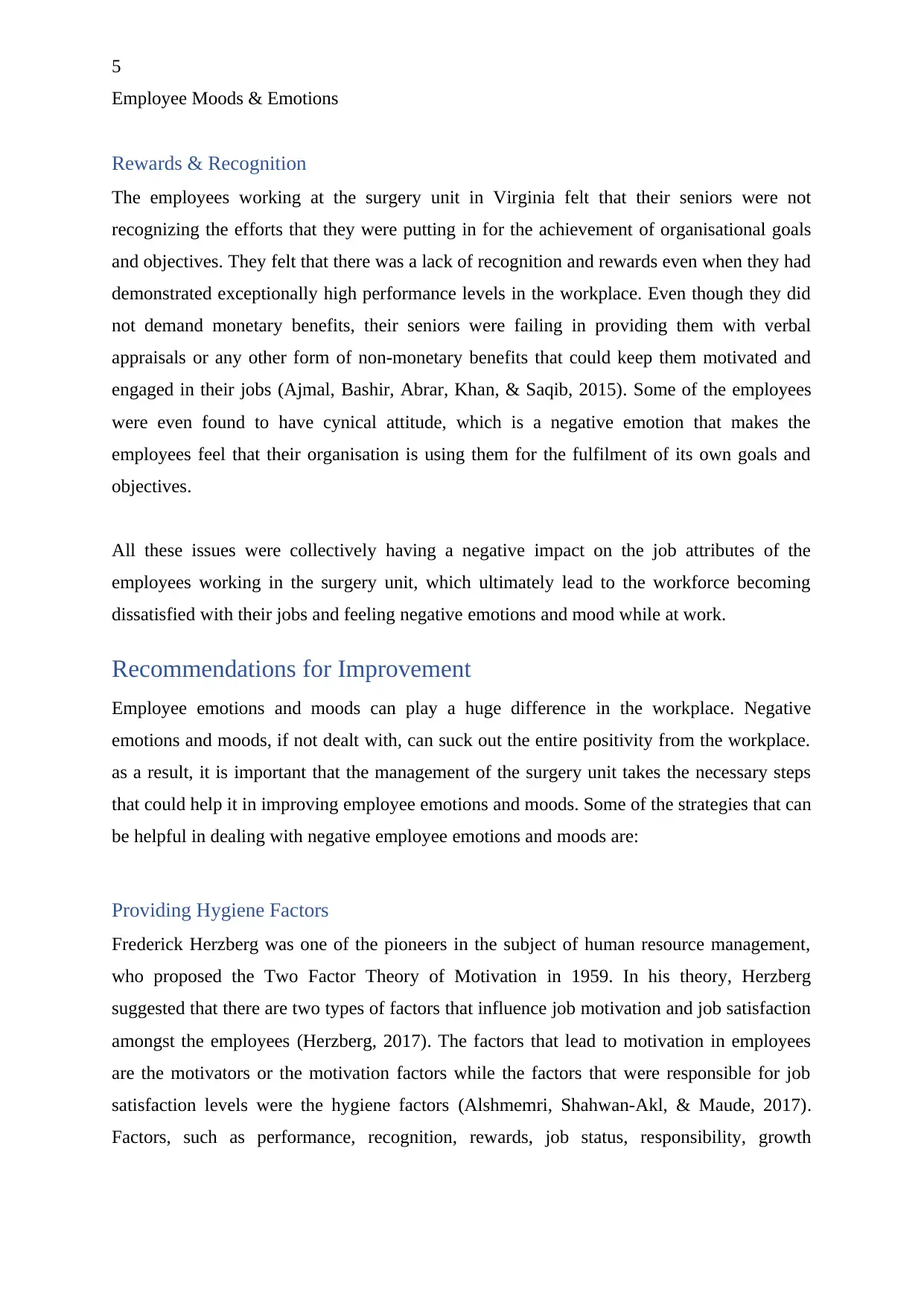
5
Employee Moods & Emotions
Rewards & Recognition
The employees working at the surgery unit in Virginia felt that their seniors were not
recognizing the efforts that they were putting in for the achievement of organisational goals
and objectives. They felt that there was a lack of recognition and rewards even when they had
demonstrated exceptionally high performance levels in the workplace. Even though they did
not demand monetary benefits, their seniors were failing in providing them with verbal
appraisals or any other form of non-monetary benefits that could keep them motivated and
engaged in their jobs (Ajmal, Bashir, Abrar, Khan, & Saqib, 2015). Some of the employees
were even found to have cynical attitude, which is a negative emotion that makes the
employees feel that their organisation is using them for the fulfilment of its own goals and
objectives.
All these issues were collectively having a negative impact on the job attributes of the
employees working in the surgery unit, which ultimately lead to the workforce becoming
dissatisfied with their jobs and feeling negative emotions and mood while at work.
Recommendations for Improvement
Employee emotions and moods can play a huge difference in the workplace. Negative
emotions and moods, if not dealt with, can suck out the entire positivity from the workplace.
as a result, it is important that the management of the surgery unit takes the necessary steps
that could help it in improving employee emotions and moods. Some of the strategies that can
be helpful in dealing with negative employee emotions and moods are:
Providing Hygiene Factors
Frederick Herzberg was one of the pioneers in the subject of human resource management,
who proposed the Two Factor Theory of Motivation in 1959. In his theory, Herzberg
suggested that there are two types of factors that influence job motivation and job satisfaction
amongst the employees (Herzberg, 2017). The factors that lead to motivation in employees
are the motivators or the motivation factors while the factors that were responsible for job
satisfaction levels were the hygiene factors (Alshmemri, Shahwan-Akl, & Maude, 2017).
Factors, such as performance, recognition, rewards, job status, responsibility, growth
Employee Moods & Emotions
Rewards & Recognition
The employees working at the surgery unit in Virginia felt that their seniors were not
recognizing the efforts that they were putting in for the achievement of organisational goals
and objectives. They felt that there was a lack of recognition and rewards even when they had
demonstrated exceptionally high performance levels in the workplace. Even though they did
not demand monetary benefits, their seniors were failing in providing them with verbal
appraisals or any other form of non-monetary benefits that could keep them motivated and
engaged in their jobs (Ajmal, Bashir, Abrar, Khan, & Saqib, 2015). Some of the employees
were even found to have cynical attitude, which is a negative emotion that makes the
employees feel that their organisation is using them for the fulfilment of its own goals and
objectives.
All these issues were collectively having a negative impact on the job attributes of the
employees working in the surgery unit, which ultimately lead to the workforce becoming
dissatisfied with their jobs and feeling negative emotions and mood while at work.
Recommendations for Improvement
Employee emotions and moods can play a huge difference in the workplace. Negative
emotions and moods, if not dealt with, can suck out the entire positivity from the workplace.
as a result, it is important that the management of the surgery unit takes the necessary steps
that could help it in improving employee emotions and moods. Some of the strategies that can
be helpful in dealing with negative employee emotions and moods are:
Providing Hygiene Factors
Frederick Herzberg was one of the pioneers in the subject of human resource management,
who proposed the Two Factor Theory of Motivation in 1959. In his theory, Herzberg
suggested that there are two types of factors that influence job motivation and job satisfaction
amongst the employees (Herzberg, 2017). The factors that lead to motivation in employees
are the motivators or the motivation factors while the factors that were responsible for job
satisfaction levels were the hygiene factors (Alshmemri, Shahwan-Akl, & Maude, 2017).
Factors, such as performance, recognition, rewards, job status, responsibility, growth
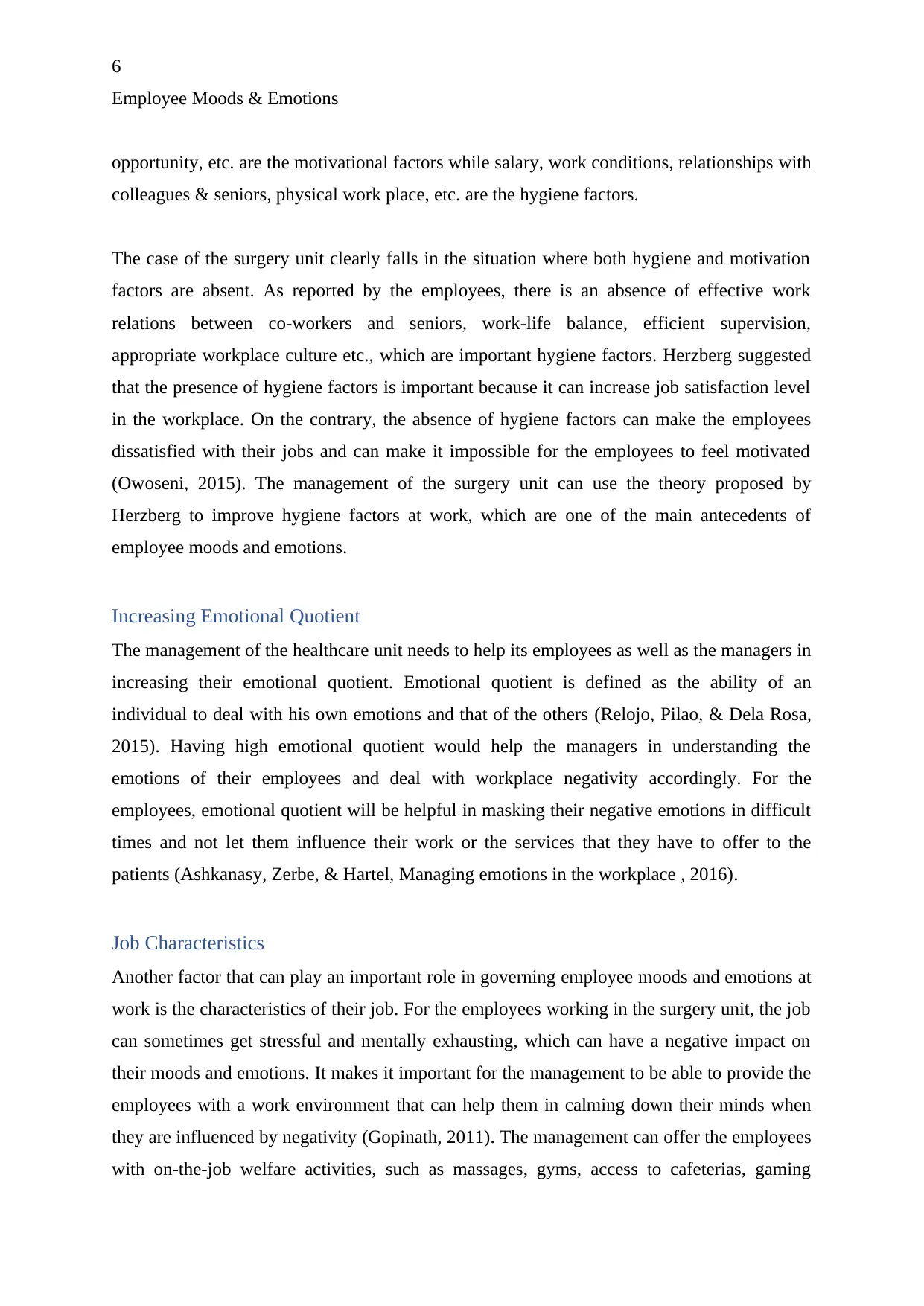
6
Employee Moods & Emotions
opportunity, etc. are the motivational factors while salary, work conditions, relationships with
colleagues & seniors, physical work place, etc. are the hygiene factors.
The case of the surgery unit clearly falls in the situation where both hygiene and motivation
factors are absent. As reported by the employees, there is an absence of effective work
relations between co-workers and seniors, work-life balance, efficient supervision,
appropriate workplace culture etc., which are important hygiene factors. Herzberg suggested
that the presence of hygiene factors is important because it can increase job satisfaction level
in the workplace. On the contrary, the absence of hygiene factors can make the employees
dissatisfied with their jobs and can make it impossible for the employees to feel motivated
(Owoseni, 2015). The management of the surgery unit can use the theory proposed by
Herzberg to improve hygiene factors at work, which are one of the main antecedents of
employee moods and emotions.
Increasing Emotional Quotient
The management of the healthcare unit needs to help its employees as well as the managers in
increasing their emotional quotient. Emotional quotient is defined as the ability of an
individual to deal with his own emotions and that of the others (Relojo, Pilao, & Dela Rosa,
2015). Having high emotional quotient would help the managers in understanding the
emotions of their employees and deal with workplace negativity accordingly. For the
employees, emotional quotient will be helpful in masking their negative emotions in difficult
times and not let them influence their work or the services that they have to offer to the
patients (Ashkanasy, Zerbe, & Hartel, Managing emotions in the workplace , 2016).
Job Characteristics
Another factor that can play an important role in governing employee moods and emotions at
work is the characteristics of their job. For the employees working in the surgery unit, the job
can sometimes get stressful and mentally exhausting, which can have a negative impact on
their moods and emotions. It makes it important for the management to be able to provide the
employees with a work environment that can help them in calming down their minds when
they are influenced by negativity (Gopinath, 2011). The management can offer the employees
with on-the-job welfare activities, such as massages, gyms, access to cafeterias, gaming
Employee Moods & Emotions
opportunity, etc. are the motivational factors while salary, work conditions, relationships with
colleagues & seniors, physical work place, etc. are the hygiene factors.
The case of the surgery unit clearly falls in the situation where both hygiene and motivation
factors are absent. As reported by the employees, there is an absence of effective work
relations between co-workers and seniors, work-life balance, efficient supervision,
appropriate workplace culture etc., which are important hygiene factors. Herzberg suggested
that the presence of hygiene factors is important because it can increase job satisfaction level
in the workplace. On the contrary, the absence of hygiene factors can make the employees
dissatisfied with their jobs and can make it impossible for the employees to feel motivated
(Owoseni, 2015). The management of the surgery unit can use the theory proposed by
Herzberg to improve hygiene factors at work, which are one of the main antecedents of
employee moods and emotions.
Increasing Emotional Quotient
The management of the healthcare unit needs to help its employees as well as the managers in
increasing their emotional quotient. Emotional quotient is defined as the ability of an
individual to deal with his own emotions and that of the others (Relojo, Pilao, & Dela Rosa,
2015). Having high emotional quotient would help the managers in understanding the
emotions of their employees and deal with workplace negativity accordingly. For the
employees, emotional quotient will be helpful in masking their negative emotions in difficult
times and not let them influence their work or the services that they have to offer to the
patients (Ashkanasy, Zerbe, & Hartel, Managing emotions in the workplace , 2016).
Job Characteristics
Another factor that can play an important role in governing employee moods and emotions at
work is the characteristics of their job. For the employees working in the surgery unit, the job
can sometimes get stressful and mentally exhausting, which can have a negative impact on
their moods and emotions. It makes it important for the management to be able to provide the
employees with a work environment that can help them in calming down their minds when
they are influenced by negativity (Gopinath, 2011). The management can offer the employees
with on-the-job welfare activities, such as massages, gyms, access to cafeterias, gaming
⊘ This is a preview!⊘
Do you want full access?
Subscribe today to unlock all pages.

Trusted by 1+ million students worldwide
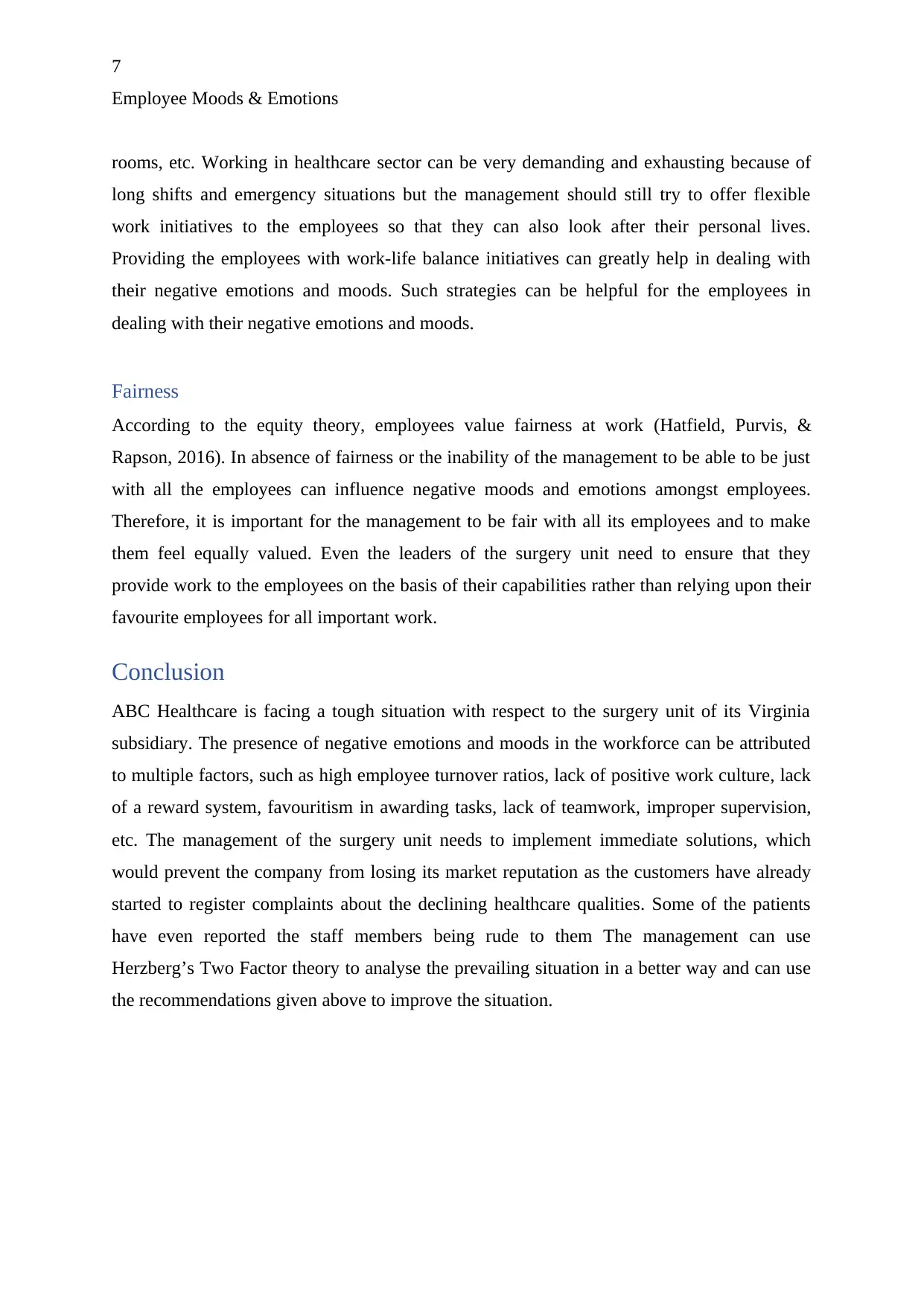
7
Employee Moods & Emotions
rooms, etc. Working in healthcare sector can be very demanding and exhausting because of
long shifts and emergency situations but the management should still try to offer flexible
work initiatives to the employees so that they can also look after their personal lives.
Providing the employees with work-life balance initiatives can greatly help in dealing with
their negative emotions and moods. Such strategies can be helpful for the employees in
dealing with their negative emotions and moods.
Fairness
According to the equity theory, employees value fairness at work (Hatfield, Purvis, &
Rapson, 2016). In absence of fairness or the inability of the management to be able to be just
with all the employees can influence negative moods and emotions amongst employees.
Therefore, it is important for the management to be fair with all its employees and to make
them feel equally valued. Even the leaders of the surgery unit need to ensure that they
provide work to the employees on the basis of their capabilities rather than relying upon their
favourite employees for all important work.
Conclusion
ABC Healthcare is facing a tough situation with respect to the surgery unit of its Virginia
subsidiary. The presence of negative emotions and moods in the workforce can be attributed
to multiple factors, such as high employee turnover ratios, lack of positive work culture, lack
of a reward system, favouritism in awarding tasks, lack of teamwork, improper supervision,
etc. The management of the surgery unit needs to implement immediate solutions, which
would prevent the company from losing its market reputation as the customers have already
started to register complaints about the declining healthcare qualities. Some of the patients
have even reported the staff members being rude to them The management can use
Herzberg’s Two Factor theory to analyse the prevailing situation in a better way and can use
the recommendations given above to improve the situation.
Employee Moods & Emotions
rooms, etc. Working in healthcare sector can be very demanding and exhausting because of
long shifts and emergency situations but the management should still try to offer flexible
work initiatives to the employees so that they can also look after their personal lives.
Providing the employees with work-life balance initiatives can greatly help in dealing with
their negative emotions and moods. Such strategies can be helpful for the employees in
dealing with their negative emotions and moods.
Fairness
According to the equity theory, employees value fairness at work (Hatfield, Purvis, &
Rapson, 2016). In absence of fairness or the inability of the management to be able to be just
with all the employees can influence negative moods and emotions amongst employees.
Therefore, it is important for the management to be fair with all its employees and to make
them feel equally valued. Even the leaders of the surgery unit need to ensure that they
provide work to the employees on the basis of their capabilities rather than relying upon their
favourite employees for all important work.
Conclusion
ABC Healthcare is facing a tough situation with respect to the surgery unit of its Virginia
subsidiary. The presence of negative emotions and moods in the workforce can be attributed
to multiple factors, such as high employee turnover ratios, lack of positive work culture, lack
of a reward system, favouritism in awarding tasks, lack of teamwork, improper supervision,
etc. The management of the surgery unit needs to implement immediate solutions, which
would prevent the company from losing its market reputation as the customers have already
started to register complaints about the declining healthcare qualities. Some of the patients
have even reported the staff members being rude to them The management can use
Herzberg’s Two Factor theory to analyse the prevailing situation in a better way and can use
the recommendations given above to improve the situation.
Paraphrase This Document
Need a fresh take? Get an instant paraphrase of this document with our AI Paraphraser
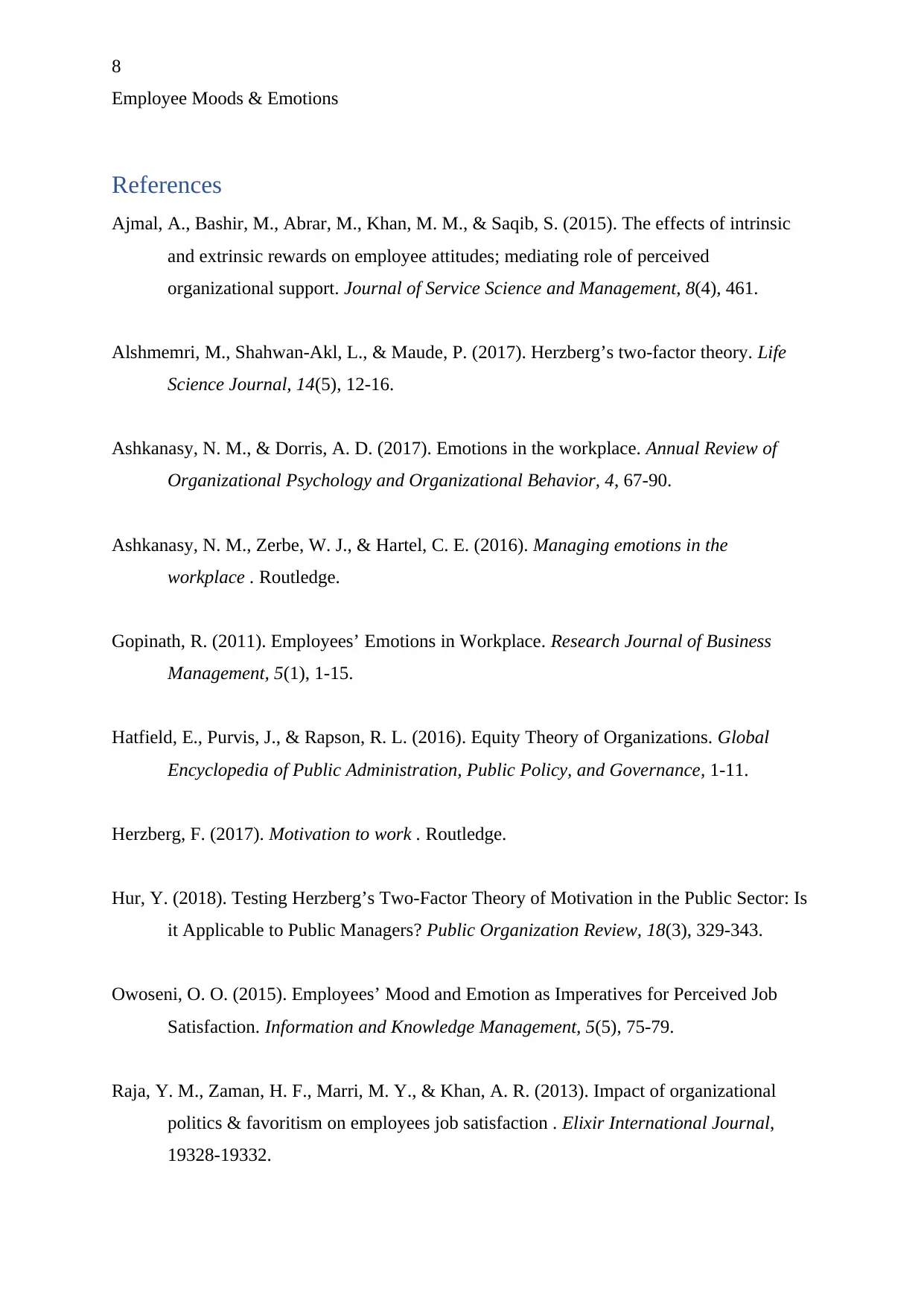
8
Employee Moods & Emotions
References
Ajmal, A., Bashir, M., Abrar, M., Khan, M. M., & Saqib, S. (2015). The effects of intrinsic
and extrinsic rewards on employee attitudes; mediating role of perceived
organizational support. Journal of Service Science and Management, 8(4), 461.
Alshmemri, M., Shahwan-Akl, L., & Maude, P. (2017). Herzberg’s two-factor theory. Life
Science Journal, 14(5), 12-16.
Ashkanasy, N. M., & Dorris, A. D. (2017). Emotions in the workplace. Annual Review of
Organizational Psychology and Organizational Behavior, 4, 67-90.
Ashkanasy, N. M., Zerbe, W. J., & Hartel, C. E. (2016). Managing emotions in the
workplace . Routledge.
Gopinath, R. (2011). Employees’ Emotions in Workplace. Research Journal of Business
Management, 5(1), 1-15.
Hatfield, E., Purvis, J., & Rapson, R. L. (2016). Equity Theory of Organizations. Global
Encyclopedia of Public Administration, Public Policy, and Governance, 1-11.
Herzberg, F. (2017). Motivation to work . Routledge.
Hur, Y. (2018). Testing Herzberg’s Two-Factor Theory of Motivation in the Public Sector: Is
it Applicable to Public Managers? Public Organization Review, 18(3), 329-343.
Owoseni, O. O. (2015). Employees’ Mood and Emotion as Imperatives for Perceived Job
Satisfaction. Information and Knowledge Management, 5(5), 75-79.
Raja, Y. M., Zaman, H. F., Marri, M. Y., & Khan, A. R. (2013). Impact of organizational
politics & favoritism on employees job satisfaction . Elixir International Journal,
19328-19332.
Employee Moods & Emotions
References
Ajmal, A., Bashir, M., Abrar, M., Khan, M. M., & Saqib, S. (2015). The effects of intrinsic
and extrinsic rewards on employee attitudes; mediating role of perceived
organizational support. Journal of Service Science and Management, 8(4), 461.
Alshmemri, M., Shahwan-Akl, L., & Maude, P. (2017). Herzberg’s two-factor theory. Life
Science Journal, 14(5), 12-16.
Ashkanasy, N. M., & Dorris, A. D. (2017). Emotions in the workplace. Annual Review of
Organizational Psychology and Organizational Behavior, 4, 67-90.
Ashkanasy, N. M., Zerbe, W. J., & Hartel, C. E. (2016). Managing emotions in the
workplace . Routledge.
Gopinath, R. (2011). Employees’ Emotions in Workplace. Research Journal of Business
Management, 5(1), 1-15.
Hatfield, E., Purvis, J., & Rapson, R. L. (2016). Equity Theory of Organizations. Global
Encyclopedia of Public Administration, Public Policy, and Governance, 1-11.
Herzberg, F. (2017). Motivation to work . Routledge.
Hur, Y. (2018). Testing Herzberg’s Two-Factor Theory of Motivation in the Public Sector: Is
it Applicable to Public Managers? Public Organization Review, 18(3), 329-343.
Owoseni, O. O. (2015). Employees’ Mood and Emotion as Imperatives for Perceived Job
Satisfaction. Information and Knowledge Management, 5(5), 75-79.
Raja, Y. M., Zaman, H. F., Marri, M. Y., & Khan, A. R. (2013). Impact of organizational
politics & favoritism on employees job satisfaction . Elixir International Journal,
19328-19332.
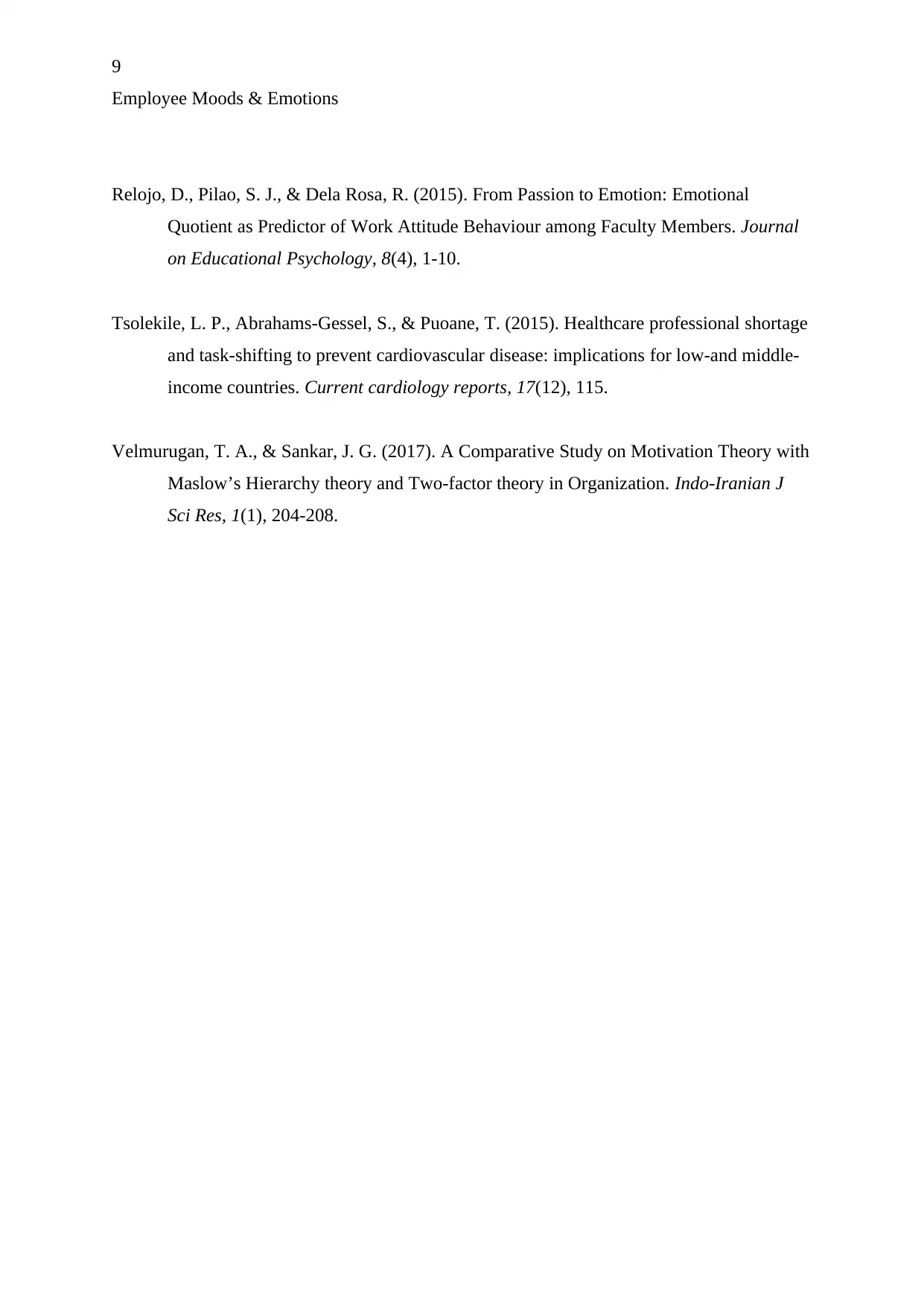
9
Employee Moods & Emotions
Relojo, D., Pilao, S. J., & Dela Rosa, R. (2015). From Passion to Emotion: Emotional
Quotient as Predictor of Work Attitude Behaviour among Faculty Members. Journal
on Educational Psychology, 8(4), 1-10.
Tsolekile, L. P., Abrahams-Gessel, S., & Puoane, T. (2015). Healthcare professional shortage
and task-shifting to prevent cardiovascular disease: implications for low-and middle-
income countries. Current cardiology reports, 17(12), 115.
Velmurugan, T. A., & Sankar, J. G. (2017). A Comparative Study on Motivation Theory with
Maslow’s Hierarchy theory and Two-factor theory in Organization. Indo-Iranian J
Sci Res, 1(1), 204-208.
Employee Moods & Emotions
Relojo, D., Pilao, S. J., & Dela Rosa, R. (2015). From Passion to Emotion: Emotional
Quotient as Predictor of Work Attitude Behaviour among Faculty Members. Journal
on Educational Psychology, 8(4), 1-10.
Tsolekile, L. P., Abrahams-Gessel, S., & Puoane, T. (2015). Healthcare professional shortage
and task-shifting to prevent cardiovascular disease: implications for low-and middle-
income countries. Current cardiology reports, 17(12), 115.
Velmurugan, T. A., & Sankar, J. G. (2017). A Comparative Study on Motivation Theory with
Maslow’s Hierarchy theory and Two-factor theory in Organization. Indo-Iranian J
Sci Res, 1(1), 204-208.
⊘ This is a preview!⊘
Do you want full access?
Subscribe today to unlock all pages.

Trusted by 1+ million students worldwide
1 out of 9
Related Documents
Your All-in-One AI-Powered Toolkit for Academic Success.
+13062052269
info@desklib.com
Available 24*7 on WhatsApp / Email
![[object Object]](/_next/static/media/star-bottom.7253800d.svg)
Unlock your academic potential
Copyright © 2020–2025 A2Z Services. All Rights Reserved. Developed and managed by ZUCOL.





